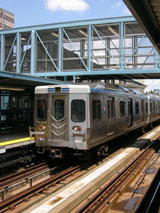 Philadelphians know SEPTA’s Market-Frankford El as the Blue Line. But a new pilot program, which stores leftover power from the subway’s regenerative braking system in a massive battery, would make the Blue Line a little greener, and provide SEPTA some much-needed capital.
Philadelphians know SEPTA’s Market-Frankford El as the Blue Line. But a new pilot program, which stores leftover power from the subway’s regenerative braking system in a massive battery, would make the Blue Line a little greener, and provide SEPTA some much-needed capital.
Earlier this month, SEPTA and Conshohocken smart-grid firm Viridity Energy announced receipt of $900,000 from the Pennsylvania Energy Development Authority to install a massive storage battery–about the size of a cement truck–at SEPTA’s Kensington electrical substation. The current regenerative braking system transmits electricity, collected as trains enter stations, to other electric vehicles. But if no other vehicles are in range, the electricity is lost. The battery, capable of storing up to a megawatt of electricity, would siphon energy to be resold to the power grid. Viridity estimates that this one battery will generate $500,000 a year in clean, green profit. SEPTA has already applied for new funding to install these battery systems at all 33 substations across their service area.
“With this technology, SEPTA can be very strategic with their power; when they are using it, when they are storing it and when they are selling it back into the grid,” says Viridity Director of Business Development Laurie Actman. “At peak periods, the grid is willing to pay premium prices for sources of reliable load.”
Since 2008, SEPTA has struggled to execute capital improvements to its transit infrastructure. Most recently, a proposed switch to SmartCards has drawn scrutiny from city media and transit bloggers. When Governor Ed Rendell made a play to turn state thoroughfare I-80 into a federal toll road, he promised a chunk of the resulting revenue to SEPTA. Since Rendell’s proposal was defeated, SEPTA has been looking for other ways to fund improvements, from fare hikes to advertising on the sides of trains. The battery system technology could be the answer they have been looking for that will finally bring the Philadelphia subway into the 21st century.
“As we all know, SEPTA has always had a constrained budget and not enough money to invest in its infrastructure,” says Actman. “For so long, SEPTA’s infrastructure, that was built nearly a century ago, has been a liability. We are turning that into an opportunity.”
Source: Laurie Actman, Viridity Energy
Writer: John Steele
For more of Greater Philadelphia’s latest and greatest, sign up here to receive Flying Kite for free every week in your inbox.